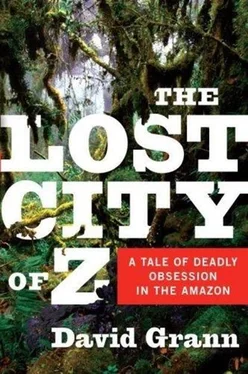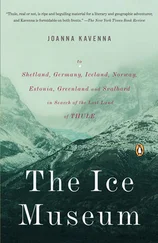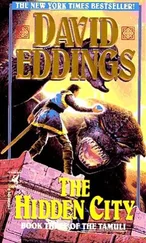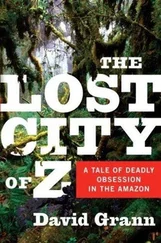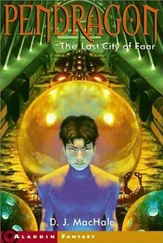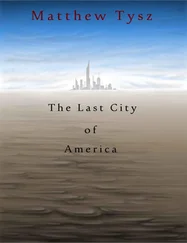After passing through the territory of the Suyás and Kayapós, the expedition would turn eastward and confront the Xavante, who were perhaps even more formidable. In the late eighteenth century, many in the tribe had been contacted by the Portuguese and moved into villages, where they received mass baptisms. Devastated by epidemics and brutalized by Brazilian soldiers, they eventually fled back into the jungle near the River of Death. A nineteenth-century German traveler wrote that “from that time onwards [the Xavante] no longer trusted any white man… These abused people have therefore changed from compatriots into the most dangerous and determined enemies. They generally kill anyone they can easily catch.” Several years after Fawcett's journey, members of the Indian Protection Service tried to make contact with the Xavante, only to return to their base camp and discover the naked corpses of four of their colleagues. One was still clutching in his hand gifts for the Indians.
In spite of the risks, Fawcett was confident-after all, he had always succeeded where others failed. “It is obviously dangerous to penetrate large hordes of Indians traditionally hostile,” he wrote, “but I believe in my mission and in its purpose. The rest does not worry me, for I have seen a good deal of Indians and know what to do and what not to do.” He added, “I believe our little party of three white men will make friends with them all.”
The guides, who were already feverish, were reluctant to go any farther, and Fawcett decided that the time had come to send them back. He selected half a dozen or so of the strongest animals to keep for a few more days. Then the explorers would have to proceed with their few provisions on their backs.
Fawcett pulled Raleigh aside and encouraged him to return with the guides. As Fawcett had written to Nina, “I suspect constitutional weakness, and fear that we shall be handicapped by him.” After this point, Fawcett explained, there would be no way to carry him out. Raleigh insisted that he would see it through. Perhaps he remained loyal to Jack, in spite of everything. Perhaps he didn't want to be seen as a coward. Or perhaps he was simply afraid to turn back without them.
Fawcett finished his last letters and dispatches. He wrote that he would try to get out other communiqués in the coming year or so, but added that it was unlikely. As he noted in one of his final articles, “By the time this dispatch is printed, we shall have long since disappeared into the unknown.”
After folding up his missives, Fawcett gave them to the guides. Raleigh had earlier written to his “dearest Mother” and family. “I shall look forward to seeing you again in old Cal when I return,” he said. And he told his brother bravely, “Keep cheerful and things will turn up alright as they have for me.”
The explorers gave a final wave to the Brazilians, then turned and headed deeper into the jungle. In his last words to his wife, Fawcett wrote, “You need have no fear of any failure.”

THE LAST EYEWITNESS
Can you get the GPS to work?” Paolo asked.
I was sitting in the backseat of a four-wheel-drive Mitsubishi truck, fiddling with a Global Positioning System in an attempt to obtain readings of our coordinates. We were heading north-that much I knew-with a driver whom we had hired when we rented the pickup. Paolo had told me that we would need a powerful truck and a professional driver if we were to have any chance of completing our journey, especially in the rainy season. “This is the worst time of year,” he said. “The roads are-how do you say in English? -shit.”
When I explained my mission to our driver, he asked me when the British colonel had disappeared.
“Nineteen twenty-five,” I said.
“And you want to find him in the jungle?”
“Not exactly.”
“Are you one of his descendants?”
“No.”
He seemed to think about this for a long moment, then said, “Very well,” and began cheerfully to load our gear, which included hammocks, rope, mosquito netting, water-purifying tablets, a satellite phone, antibiotics, and malarial pills. On our way out of Cuiabá, we also picked up a friend of Paolo's, a descendant of a Bakairí chief named Taukane Bakairí. (In Brazil, the last names of Indians are typically the same as that of their tribe.) Taukane, who was in his mid-forties and had a handsome, round face, wore Levi's and a baseball cap. He had been educated by missionaries, and though he now lived mostly in Cuiabá, he continued to represent his tribe's political interests. “I am what you might call an ambassador,” he told me. And, in exchange for a “gift” of two tires for a communal tractor, he had agreed to take us to his village, the last place that Fawcett had incon-trovertibly been seen. (“If it were up to me, I would take you for free,” Taukane said. “But all Indians must now be capitalists. We have no choice.”)
Upon leaving the city, we entered the central plains of Brazil, which mark the transition from dry forest to rain forest. After a while, a plateau came into view: Martian red in color, it spanned more than two thousand square miles, an endless tabletop that reached into the clouds. We stopped at its base, and Paolo said, “Come, I show you something.”
We left the truck and climbed a steep, rocky slope. The ground was moist from a recent rainstorm, and we used our hands and knees to ascend, crawling over holes where snakes and armadillos had burrowed.
“Where are we going?” I asked Paolo, who had another cigarette clamped between his teeth.
“You Americans are always impatient,” he said.
Lightning streaked the sky and a thin mist descended, making the ground more slippery. Rocks gave way under our feet, clapping as they hit the ground, fifty yards below.
“Almost there,” Paolo said.
He helped to pull me up a ledge, and as I got to my feet, covered in mud, he pointed at another ridge, a few yards away, and said, “Now you see!”
Jutting into the sky was a cracked stone column. I blinked in the rain-in fact, there was not just one but several columns in a row, as in a Greek ruin. There was also a large archway, both sides of it intact, and behind it was a dazzlingly large tower. They looked like what the bandeirante had described in 1753.
“What is it?” I asked.
“Stone city.”
“Who built it?”
“It is-how do you say?-an illusion.”
“That?” I said, pointing to one of the columns.
“It was made by nature, by erosion. But many people who see it think it is a lost city, like Z.”
In 1925, Dr. Rice had seen similarly eroded cliffs, in Roraima, Brazil, and thought they looked like “ruined architecture.”
As we returned to the car and headed north, toward the jungle, Paolo said we would find out soon if Z were such a mirage. We eventually turned onto BR-163, one of the most treacherous roads in South America. Built in 1970 by the Brazilian government in an effort to open up the country's interior, it extends more than a thousand miles, from Cuiabá to the Amazon River. It was designated on our map as a major highway, but almost all the asphalt from its two lanes had been washed away during the rainy season, leaving behind a combination of ditches and puddle-filled gullies. Our driver sometimes chose to ignore the road altogether and steer along the rocky banks and fields, where herds of cattle occasionally parted in our midst.
As we passed the Manso River, where Fawcett had gotten separated from the rest of the group and where Raleigh had been bitten by ticks, I kept looking out the window, expecting to see the first signs of a fearsome jungle. Instead, the terrain looked like Nebraska-perpetual plains that faded into the horizon. When I asked Taukane where the forest was, he said, simply, “Gone.”
Читать дальше
Конец ознакомительного отрывка
Купить книгу
